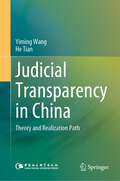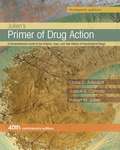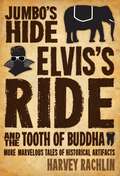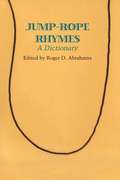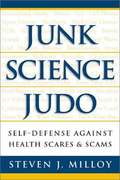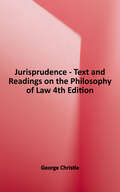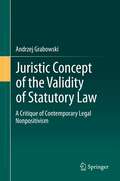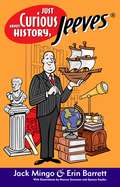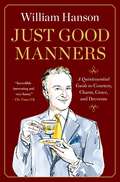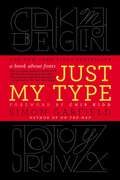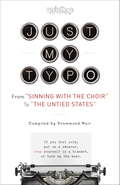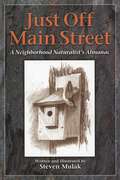- Table View
- List View
Judicial Transparency in China: Theory and Realization Path
by Yiming Wang He TianBased on the Judicial Transparency Index Assessment (2019 and 2020) conducted in China by the Institute of Law of the Chinese Academy of Social Sciences, this book summarizes and analyzes the current situation of judicial openness in China, using a sample of 218 courts across the country for the study. The book analyzes the ideological and institutional origins of judicial openness and examines the operation of judicial openness through the practical experience of role replacement. By analyzing evaluation data in the fields of audit information disclosure, trial information disclosure, judicial enforcement data disclosure, and judicial reform data disclosure, the book points out that the current judicial disclosure has made significant progress, but there are still problems such as unclear disclosure standards, insufficient rigidity in disclosure requirements, and the scope of disclosure still needs to be expanded. The book recommends accelerating the disclosure of judicial legislation, public standards, and strengthening assessment and accountability.
Julia’s Kitchen Wisdom: Essential Techniques and Recipes from a Lifetime of Cooking
by Julia Child David Nussbaum<p>In this indispensable volume of kitchen wisdom, Julia Child gives home cooks the answers to their most pressing kitchen questions. How many minutes should you cook green beans? What are the right proportions for a vinaigrette? How do you skim off fat? What is the perfect way to roast a chicken? <p> Here Julia provides solutions for these and many other everyday cooking queries. How are you going to cook that small rib steak you brought home? You'll be guided to the quick sauté as the best and fastest way. And once you've mastered that recipe, you can apply the technique to chops, chicken, or fish, following Julia's careful guidelines. Julia’s Kitchen Wisdom is packed with essential information about soups, vegetables, and eggs, for baking breads and tarts, and more, making it a perfect compendium of a lifetime spent cooking.
Julien's Primer of Drug Action
by Robert M. Julien Claire D. Advokat Joseph E. ComatyIn its 40th anniversary edition, A Primer of Drug Action continues to evolve side by side with the field it covers, drawing on the expertise of its authors in medicine, basic science, and clinical science to offer the most current and comprehensive guide to psychopharmacology available.
Jumbo's Hide, Elvis's Ride, and the Tooth of Buddha: More Marvelous Tales of Historical Artifacts
by Harvey RachlinOnce again historian Harvey Rachlin uncovers odd and stirring stories behind some of the most fascinating objects in the world. "Jumbo's Hide," Publisher's Weekly writes, "is entertaining and enlightening … a pageant of human aspiration, achievement, obsession, and belief." Artifacts explored include: The truce flag that ended World War I, The Maltese Falcon, John Adam's pigtail and Jesse James' Stickpin and Galileo's middle finger.
Jump-Rope Rhymes: A Dictionary
by Roger D. AbrahamsThis collection of over six hundred jump-rope rhymes, originally published in 1969, is an introduction into the world of children—their attitudes, their concerns, their humor. Like other children's folklore, the rhymes are both richly inventive and innocently derivative, ranging from on-the-spot improvisations to old standards like "Bluebells, cockleshells," with a generous sprinkling of borrowings from other play activities—nursery rhymes, counting-out rhymes, and taunts.
Jungle Survival (Air Ministry Survival Guide #2)
by A.M. Pamphlet 224THE ULTIMATE SURVIVAL GUIDE for anyone who thinks they'd survive the world's most hostile environments - or at least imagine they could do.-----------------------------First issued to airmen in the 1950s, the Air Ministry's Sea Survival guide includes original and authentic emergency advice to crew operating over the ocean. With original illustrations and text, these survival guides provide an insight to military survival techniques from a by-gone era.Packed with original line drawings and instruction in:- What to do if 'jungle hiking becomes boring'- How to stay safe from poisonous reptiles and insects- The benefits of using a 'fire thong'Focussing on one of the most hostile environments on Earth, Jungle Survival is one of four reprints of The Air Ministry's emergency survival pamphlets. Others include:Sea SurvivalDesert SurvivalArctic Survival
Junk Science Judo: Self Defense Against Health Scares And Scams
by Steven J. MilloyMilloy offers a mixed bag to mainstream readers: At the same time that he educates about the manipulation of science by special interests hoping to attract money and mindshare to their causes, he also manages to thrust on readers his own personal agenda, which tends to demonize all consumer and en
Juridical Perspectives between Islam and the West: A Tale of Two Worlds (Global Issues)
by Federico Lorenzo RamaioliThis comparative philosophy of law book aims at formulating a new analytical approach to the Islamic legal tradition based on ‘juridical categories’, a concept that facilitates comprehension and understanding of juridical phenomena. Building upon legal comparativism and legal pluralism, this project intends to avoid bias caused by universalizing Western categories when analyzing foreign juridical notions, which inevitably results in the miscomprehension of non-Western ideas and institutions. Unlike existing literature, this project will not focus on substantive comparisons between normative contents, but on the ‘juridical perspectives’ that helped to shape the Islamic and Western legal orders.The book focuses on the most relevant juridical questions regarding the Islamic and Western legal perspectives, such as the different visions regarding juridical spatiality, the role of human reason and the relationship between law, man and the divinity. While contributing to legal philosophy, this work intends also to develop and define a new interdisciplinary approach, aiming to provide a starting point for novel analyses in research fields such as legal comparativism, legal pluralism, and constitutional law. Finally, by formulating a new interdisciplinary approach, it will provide a foundational discussion of a continuously evolving subject that will never be exhaustively explored. As such, it aims at broadening scholarly reflections on the relationship between the West and Islam, eventually placing these concepts within a suitably comprehensive and contextualized framework. "Published in cooperation with gLAWcal - Global Law Initiatives for Sustainable Development, Hornchurch, Essex, United Kingdom".
Jurisprudence An Introduction: சட்டவியல் ஓர் அறிமுகம்
by T. Sivakumarஇந்நூலை நீதித்துறை பற்றிய அறிமுக நூல் என்று கூற முடியாது. பயணத்தின் போது அடுத்தடுத்து சிவப்பு மற்றும் மஞ்சள் விளக்குகள் நிரம்பிய நெரிசல் மிகுந்த சாலையில் குறுகிய பச்சை விளக்கின் மட்டுப்படுத்தப்பட்ட அனுமதியுடன் வெளிப்படும் நீதித்துறையின் அறிமுகத்திற்கான அறிமுகம் அல்லது அறிமுக புத்தகம் என்று கூறலாம்
Jurisprudence, Text and Readings on the Philosophy of Law (American Casebook Series)
by George G. ChristieThis book is designed for use in courses in law schools and university departments of philosophy. It can serve as a text for basic and advanced courses and seminars. Readings include excerpts of classic works of Aristotle, Aquinas, Locke, Hobbes, Kant, Bentham, and Austin. Also included are excerpts from standard works of twentieth-century philosophers. The book explores current legal discourse with readings on topics such as sociobiology, Islamic law, the legal process school, legal feminism, critical legal studies, intersectionality and gender identity theories, law and economics, and new private law theories. It reprints leading cases on natural rights/human rights and readings from online blogs, op-ed essays, news stories and internet publications, as well as drawing on literary treatment of topics relevant to legal philosophy.
Juristic Concept of the Validity of Statutory Law: A Critique of Contemporary Legal Nonpositivism
by Malgorzata Kieltyka Andrzej GrabowskiThis book presents the theory of the validity of legal norms, aimed at the practice of law, in particular the jurisdiction of the constitutional courts. The postpositivist concept of the validity of statutory law, grounded on a critical analysis of the basic theories of legal validity elaborated up to now, is introduced. In the first part of the book a contemporary German nonpositivist conception of law developed by Ralf Dreier and Robert Alexy is analysed in order to answer the question whether the juristic concept of legal validity should include moral standards or criteria. In the second part, a postpositivist concept of legal validity and an innovative model of validity discourse, based on the juristic presumption of the validity of legal norms, are proposed. The book is a work on analytical legal theory, written from a postpositivist, detached point of view.
Just Be You: Inspirational Quotes and Awesome Affirmations for Staying True to Yourself
by Summersdale PublishersTake courage and comfort from the uplifting quotations and powerful affirmations in this pocket-sized collection of unbeatable confidenceThere’s nobody quite like you. Your passions and possibilities are limitless, even when the world tries to get you down. This little book, packed full of empowering quotes and valuable reminders, is the perfect companion on your journey to greater happiness and stronger self-belief.From the timeless ideas of ancient sages to sound advice from modern superstars, these are words to get you feeling great and thinking big.As well as the hard-won wisdom of successful writers, artists and thinkers, this book includes a host of uplifting mantras and daily reminders such as:You don’t have to be perfect to be wonderfulEverything you need – your courage, strength, compassion and love – is already within youYou’re only confined by the walls you build yourselfDon’t just be good to others – be good to yourself tooYou are at your most powerful when you don’t seek the approval of others
Just Be You: Inspirational Quotes and Awesome Affirmations for Staying True to Yourself
by Summersdale PublishersTake courage and comfort from the uplifting quotations and powerful affirmations in this pocket-sized collection of unbeatable confidenceThere’s nobody quite like you. Your passions and possibilities are limitless, even when the world tries to get you down. This little book, packed full of empowering quotes and valuable reminders, is the perfect companion on your journey to greater happiness and stronger self-belief.From the timeless ideas of ancient sages to sound advice from modern superstars, these are words to get you feeling great and thinking big.As well as the hard-won wisdom of successful writers, artists and thinkers, this book includes a host of uplifting mantras and daily reminders such as:You don’t have to be perfect to be wonderfulEverything you need – your courage, strength, compassion and love – is already within youYou’re only confined by the walls you build yourselfDon’t just be good to others – be good to yourself tooYou are at your most powerful when you don’t seek the approval of others
Just Be You: Positive Quotes and Affirmations for Self-Care
by Summersdale PublishersHaving a wobbly day, week or year? This little book of uplifting quotations and powerful affirmations will help you to realise you are the best person you could possibly be – you!
Just Be You: Positive Quotes and Affirmations for Self-Care
by Summersdale PublishersHaving a wobbly day, week or year? This little book of uplifting quotations and powerful affirmations will help you to realise you are the best person you could possibly be – you!
Just Clean Enough: Home Organization in an Imperfect World
by I. B. Caruso Jenny SchroedelA clean house means peace of mind. But who has the time to keep on top of it? Fortunately, this book breaks down home organization and gives busy families a solution. Unlike other decluttering books that press for perfection, this flexible guide features tips for each room in the house and helps you tackle your clutter in any way that works for you. With helpful icons that highlight quick tasks more suitable for weeknights as well as time-consuming jobs best left for the weekend, you will clean up and still have time for fun! After all, why spend all day cleaning when it's easy to do small things, like: dump out the junk drawer, toss unnecessary papers, corral kids' toys, clean out the medicine cabinet. Before long, you will be able to clean up your act--one closet, one room, one day at a time!
Just Curious About Animals and Nature, Jeeves
by Barrett MingoHOW MUCH ELECTRICITY CAN YOU GET FROM AN ELECTRIC EEL? WHEN CAN MISTLETOE BE THE KISS OF DEATH? HOW MANY SHEEP DOES IT TAKE TO GET ENOUGH WOOL FOR A SUIT? WHAT DID BOOK WORMS EAT BEFORE THERE WERE BOOKS? The mysteries of the natural world are endless, but your trusty manservant, Jeeves, has the answers to hundreds of nature's most fascinating mysteries. Based upon questions received at the popular Ask Jeeves® website, Just Curious About Animals and Nature, Jeeves is a fun and freewheeling safari of discovery that can tame even the most savage intellectual curiosity. Packed with incredible facts on everything from the size of a giraffe's tongue (yow, two feet!) to just how fast a fly can fly (4.5mph) to whether dogs have belly buttons (yes, they do), this is a book certain to both amuse and amaze. With a little help from everybody's butler, you'll unlock the secret behind the firefly's glow, wonder at the language of hippos, and scratch your head when you learn the truth about poison ivy. Certain to help you develop the kind of brainpower that will impress your friends and frighten your enemies, Just Curious About Animals and Nature, Jeeves is perfect for fans of flora and fauna, or for anyone who wants to know the whats, whens, whys, and hows of nature.
Just Curious About History, Jeeves®
by Jack Mingo Erin BarretYou'll get the answers to these fascinating questions and many, many more in the wildly entertaining, un-put-down-able Just Curious About History, Jeeves. Based on the legion of unexpected questions posed at the popular Ask Jeeves Web site, Just Curious tackles all the puzzlers, bafflers, and stumpers that find their way into our everyday lives. What were the Pig Wars and were they actually caused by pigs? Who were the first gangsters? Did Cleopatra really wear makeup? Was Ivan the Terrible that terrible? Sure curiosity killed the cat, but satisfaction brought him back. So if you want to know how tall Napoleon was, whether Captain Kidd had any little Kidds, or who the heck Charles the Fat was, look no further than Just Curious About History, Jeeves- the unequivocal say-all, end-all, be-all authority on history's who, what, where, when, why, and how.
Just Good Manners: A Quintessential Guide to Courtesy, Charm, Grace, and Decorum
by William HansonINTERNATIONAL BESTSELLER From William Hanson, the beloved social media star and etiquette authority, comes the quintessential guide to courtesy, charm, grace, and decorum.What is the correct way to get out of dreaded small talk? How do you end an email in way that is both polite and firm? How do you set a table fit for a king, or better yet, Martha Stewart? Don&’t worry, William Hanson—&“Emily Post for the TikTok generation&” (Vanity Fair)—is here to make us practically perfect in every way. In the &“funny and unapologetic&” (Robert Hardman, author of Charles III) Just Good Manners, he shares his definitive advice on how to behave in every situation, from a night dining out with friends to Netflix at home, as well as celebrates the deep kindness, empathy, and joy that come with good manners. As Hanson makes clear, to care for others is truly about caring and respecting oneself. With the perfect dose of Hanson&’s inimitable dry humor, Just Good Manners is &“a must for anyone who aspires to polish up their manners&” (Anne Glenconner, New York Times bestselling author).
Just Green It!
by Ron Beres Lisa BeresGoing Green has never been so easy!The array of so-called "green" products on the market is dizzying and often misleading. Consumers need one reference book that clearly lays out what is the better choice--between brands, benefits, and costs. Just Green It! compares brand-name products, making it easy for consumers to make environmentally friendly choices on everything from light bulbs to mattresses to baby food. It tells you which products are the best for the planet and also healthy for you, your kids, your home, and your budget. For the average consumer, this means clarity of green definitions and product comparisons that are no longer a luxury, but a necessity.Authors Ron and Lisa Beres debunk the "greenwashing" that is so prevalent in modern marketing and teach readers how to know the difference between such confusing terms as "natural," "organic," "chemical free," and "nontoxic."Full of surprising facts and lots of ways to save money and help the environment, this is an essential book for the modern age. Did you know that ...The Great Wall of China and the Staten Island Landfill--Fresh Kills--are the only two manmade structures on Earth that are large enough to be seen from outer space.It is a higher carbon footprint to drink imported vodka?The phosphoric acid in soda leaches calcium from our bones and can lead to osteoporosis?The Green Movement is concerned about the effects of our collective carbon footprint on the planet. A "green home" is one that does not endanger the planet's health. The Beres, on the other hand, are concerned with how our footprint is endangering the health and well being of each individual.A guidebook for navigating the oversaturated Green marketplace, Just Green It! is a must have for today's tough economy. Just GREEN It! was chosen in May 2011 as an honorable mention by San Francisco's 2011 Green Book Festival
Just Like Dad Says: A Book of Dad's Wit
by Geoff Tibballs'I won't lie to you, fatherhood isn't easy like motherhood' Homer SimpsonFathers come in many guises - wise or silly, strict or kind. They can make you laugh and they can make you cringe. They can drive you home and they can drive you mad ...In Just Like Dad Says, wise and witty words from the likes of Billy Connolly, Jerry Seinfeld, Spike Milligan and Homer Simpson cover everything from the joy of being a new dad to waving kids off as they - finally - leave home. Old and new, laugh-out-loud funny or wickedly dry, Just Like Dad Says is the best ever collection of quotes by and about Dad. 'My father only hit me once - but he used a Volvo' Bob Monkhouse'Even very young children need to be informed about dying. Explain the concept of death very carefully to your child. This will make threatening him with it much more effective' P.J. O'Rourke
Just Like Mum Says: A Book of Mum's Wit
by Rosemarie Jarski'Having a baby is like watching two very inefficient removal men trying to get a very large sofa through a very small doorway, only in this case you can't say, "Oh, sod it, bring it through the French windows"' Victoria Wood'It's not easy being a mother. If it were, fathers would do it' Dorothy, The Golden Girls Motherhood is a tough job and a serious business. Which means there's all the more reason to step back and see the funny side of it, and Just Like Mum Says is packed with humorous insights and wry observations on all matters maternal.Tracing the course of mothering through pregnancy, the terrible twos, the teenage years and the empty nest, Just Like Mum Says includes wise and witty words from celebrated matriarchs from Marge Simpson to Sharon Osbourne, and Victoria Beckham to Victoria Wood.In short, Just Like Mum Says amuses, delights, enlightens and touches the heart - just like Mum.'When my husband comes home, if the kids are still alive, I figure I've done my job' Roseanne
Just My Type: A Book About Fonts
by Simon GarfieldA hugely entertaining and revealing guide to the history of type that asks, What does your favorite font say about you? Fonts surround us every day, on street signs and buildings, on movie posters and books, and on just about every product we buy. But where do fonts come from, and why do we need so many? Who is responsible for the staid practicality of Times New Roman, the cool anonymity of Arial, or the irritating levity of Comic Sans (and the movement to ban it)?Typefaces are now 560 years old, but we barely knew their names until about twenty years ago when the pull-down font menus on our first computers made us all the gods of type. Beginning in the early days of Gutenberg and ending with the most adventurous digital fonts, Simon Garfield explores the rich history and subtle powers of type. He goes on to investigate a range of modern mysteries, including how Helvetica took over the world, what inspires the seeming ubiquitous use of Trajan on bad movie posters, and exactly why the all-type cover of Men are from Mars, Women are from Venus was so effective. It also examines why the "T" in the Beatles logo is longer than the other letters and how Gotham helped Barack Obama into the White House. A must-have book for the design conscious, Just My Type's cheeky irreverence will also charm everyone who loved Eats, Shoots & Leaves and Schott's Original Miscellany.
Just My Typo
by Drummond MoirA charming collection of typographical errors, slips of the pen, and embarrassing misprints, Just My Typo celebrates the awful and the sublime mistakes that riddle our feeble human attempts at communication. It's time to accept the truth: typos are everywhere. Legal documents are riddled with errors, headlines of respectable publications are rife with misspellings, and even your favorite books need a few reprints to get everything right. Isn't it time we learned to laugh at our mistakes instead of despairing? Just My Typo is an irresistible collection of the most humorous, mistakenly poignant, and downright awful typos in texts, from the Bible to insurance advertisements to political slogans. Within these pages, you'll travel back in time with great figures from history, such as Sir Francis Drake (who circumcised the world in a small ship) and Rambo (the famous French poet). You'll also find valuable moral instruction ("Blessed are the meek, for they shall irrigate the earth."), and meet politicians who exploit disasters to boost their pubic profiles. Structured according to categories (such as, "To Be or To Be: Typos in Literature"), you'll easily find either a quick laugh or a relaxing--and cringe-inducing--read. A few more of the gems within: · "The Queen pissed graciously over the Menai Bridge." · "I am certain of one thing. Whatever may come between us--and wherever he may be on earth--Arthur will always remember that I love ham." (The Parting, Millicent Hemming) · "Love is just a passing fanny." Editors, proofreaders, and writers everywhere pull their hair out trying to eliminate mistakes, to no avail. Celebrating the humanity of our errors and the timelessness of mistakes, Just My Typo is essential reading for anyone who values the power and peril of the written word.From the Trade Paperback edition.
Just Off Main Street
by Steven MulakIn Just Off Main Street, author Steven Mulak takes us on a seasonal tour that, month by month, celebrates his beloved New England's landscape, as well as the people, plants, and animals that occupy it. Mulak explores his personal world just off Main Street in such a wise, reflective manner that we more fully appreciate the observational skill emotionally uplifting sight of spring's first willows to the kaleidoscope of autumn color, to the occasional despair of never-ending winter, this book offers a fresh look at New England. The meticulous eye of the fine artist he is.
